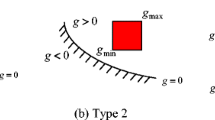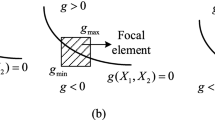Abstract
Parametric correlation exists widely in engineering problems. This paper presents an approach of evidence-theory-based design optimization (EBDO) with parametric correlations, which provides an effective computational tool for the structural reliability design involving epistemic uncertainties. According to the existing samples, the most fitting copula function is selected to formulate the joint basic probability assignment (BPA) of the correlated variables. The joint BPA is applied in the constraint reliability analysis, and an approximate technology is given to enhance the efficiency. A decoupling strategy is proposed for transforming the nested optimization of EBDO into a sequential iterative process of deterministic optimization and reliability analysis. The effectiveness of the proposed approach is demonstrated through two numerical examples and an engineering application.










Similar content being viewed by others
References
Agarwal H, Renaud JE, Preston EL, Padmanabhan D (2004) Uncertainty quantification using evidence theory in multidisciplinary design optimization. Reliab Eng Syst Saf 85(1):281–294
Akaike H (1974) A new look at the statistical model identification. IEEE T Automat Contr 19(6):716–723
Alyanak E, Grandhi R, Bae HR (2008) Gradient projection for reliability-based design optimization using evidence theory. Eng Optim 40(10):923–935
Bae HR, Grandhi RV, Canfield RA (2003) Structural design optimization based on reliability analysis using evidence theory (no. 2003-01-0877). SAE technical paper
Breitung K (1991) Probability approximations by log likelihood maximization. J Eng Mech 117(3):457–477
Caselton WF, Luo W (1992) Decision making with imprecise probabilities: dempster-Shafer theory and application. Water Resour Res 28(12):3071–3083
Dempster AP (1967) Upper and lower probabilities induced by a multivalued mapping. Ann Math Stat 38(2):325–339
Dong W, Shah HC (1987) Vertex method for computing functions of fuzzy variables. Fuzzy Sets Syst 24(1):65–78
Du X (2006) Uncertainty analysis with probability and evidence theories. In ASME 2006 International Design Engineering Technical Conferences and Computers and Information in Engineering Conference (pp. 1025–1038). American Society of Mechanical Engineers
Du X, Chen W (2002) Sequential optimization and reliability assessment method for efficient probabilistic design. J Mech Des 126(2):871–880
Elishakoff I, Colombi P (1993) Combination of probabilistic and convex models of uncertainty when scarce knowledge is present on acoustic excitation parameters. Comput Methods Appl Mech Eng 104(2):187–209
Ferson S, Hajagos J, Berleant D, Zhang J, Tucker WT, Ginzburg L, Oberkampf W (2004) Dependence in dempster-shafer theory and probability bounds analysis. US: Sandia National Laboratories. https://ualr.edu/jdberleant/papers/Sandia04.pdf
Fishman G (2013) Monte Carlo: concepts, algorithms, and applications. Springer Science & Business Media, Berlin
Fletcher R (2013) Practical methods of optimization. John Wiley & Sons, Hoboken
Friswell MI, Mottershead JE (1995) Finite element model updating in structural dynamics. Finite element model updating in structural dynamics. Kluwer Academic Publishers, Dordrecht
Georgescu I (2012) Possibility theory and the risk. Springer, Berlin, p 274
Goda K (2010) Statistical modeling of joint probability distribution using copula: application to peak and permanent displacement seismic demands. Struct Saf 32(2):112–123
Grubbs F (1958) An introduction to probability theory and its applications. Technometrics 9(2):342–342
Guoqiang C, Jianping T, Yourui T (2018) A reliability-based multidisciplinary design optimization method with evidence theory and probability theory. Int J Reliab Qual Saf Eng 25(01):1850003. https://doi.org/10.1142/S0218539318500031
Gupta MM (1992) Fuzzy set theory and its applications. Fuzzy Sets Syst 47(3):396–397
Haldar A, Mahadevan S, Haldar A, Mahadevan S (2013) Probability, reliability and statistical methods in engineering design (haldar, mahadevan). Bautechnik 77(5):379–379
Hoffman FO, Hammonds JS (1994) Propagation of uncertainty in risk assessments: the need to distinguish between uncertainty due to lack of knowledge and uncertainty due to variability. Risk Anal 14(5):707–712
Huang ZL, Jiang C, Zhang Z, Fang T, Han X (2017) A decoupling approach for evidence-theory-based reliability design optimization. Struct Multidiscip Optim 56(3):647–661
Huard D, Evin G, Favre AC, Azen SP (2006) Bayesian copula selection. Comput Stat Data Anal 51(2):809–822
Jiang C, Han X, Lu GY, Liu J, Zhang Z, Bai YC (2011) Correlation analysis of non-probabilistic convex model and corresponding structural reliability technique. Comput Methods Appl Mech Eng 200(33):2528–2546
Jiang C, Han X, Liu W, Liu J, Zhang Z (2012) A hybrid reliability approach based on probability and interval for uncertain structures. J Mech Des 134(3):031001
Jiang C, Zhang Z, Han X, Liu J (2013) A novel evidence-theory-based reliability analysis method for structures with epistemic uncertainty. Comput Struct 129(4):1–12
Jiang C, Zhang W, Wang B, Han X (2014) Structural reliability analysis using a copula-function-based evidence theory model. Comput Struct 143:19–31
Jiang C, Zhang W, Han X, Ni BY, Song LJ (2015) A vine-copula-based reliability analysis method for structures with multidimensional correlation. J Mech Des 137(6):061405
Joe H (1997) Multivariate models and multivariate dependence concepts. Chapman and Hall. CRC, Boca Raton
Kang Z, Luo Y (2009) Non-probabilistic reliability-based topology optimization of geometrically nonlinear structures using convex models. Comput Methods Appl Mech Eng 198(41):3228–3238
Kiureghian AD, Ditlevsen O (2009) Aleatory or epistemic? Does it matter? Struct Saf 31(2):105–112
Liu B (2010) Uncertain risk analysis and uncertain reliability analysis. J Uncertain Syst 4(3):163–170
Melchers RE (1987) Structural reliability analysis and prediction. Wiley, Hoboken
Meng D, Zhang H, Huang T (2016) A concurrent reliability optimization procedure in the earlier design phases of complex engineering systems under epistemic uncertainties. Adv Mech Eng 8(10):1687814016673976
Mourelatos ZP, Zhou J (2006) A design optimization method using evidence theory. J Mech Des 128(4):901–908
Nelsen B (2006) An introduction to copulas. Springer, New York
Nikolaidis E, Dan MG, Singhal S (2004) Engineering design reliability handbook. Technometrics 48(1):156–156
Noh Y, Choi KK, Du L (2008) Reliability-based design optimization of problems with correlated input variables using a Gaussian copula. Struct Multidiscip Optim 38(1):1–16
Noh Y, Choi KK, Lee I (2010) Identification of marginal and joint CDFs using Bayesian method for RBDO. Struct Multidiscip Optim 40(1–6):35–51
Qiu Z, Yang D, Elishakoff I (2008) Probabilistic interval reliability of structural systems. Int J Solids Struct 45(10):2850–2860
Sentz K, Ferson S (2002) Combination of evidence in Dempster-Shafer theory Vol. 4015. Sandia National Laboratories, Albuquerque
Shafer G (1976) A mathematical theory of evidence. Princeton university press, Princeton
Sheynkin Y, Jung M, Yoo P, Schulsinger D, Komaroff E (2005) Increase in scrotal temperature in laptop computer users. J Urol 20(2):452–455
Simon C, Weber P, Levrat E (2007) Bayesian networks and evidence theory to model complex systems reliability. J Comput 2(1):33–43
Sklar M (1959) Fonctions de repartition an dimensions et leurs marges. Publ Inst Statist Univ Paris 8:229–231
Srivastava RK, Deb K, Tulshyan R (2013) An evolutionary algorithm based approach to design optimization using evidence theory. J Mech Des 135(8):1885–1886
Stewart DE (2000) Rigid-body dynamics with friction and impact. SIAM Rev 42(1):3–39
Sun B, Ma W, Zhao H (2014) Decision-theoretic rough fuzzy set model and application. Inf Sci 283(5):180–196
Tang XS, Li DQ, Zhou CB, Phoon KK, Zhang LM (2013) Impact of copulas for modeling bivariate distributions on system reliability. Struct Saf 44:80–90
Thanedar PB, Kodiyalam S (1992) Structural optimization using probabilistic constraints. Struct Optim 4(3–4):236–240
Tzvieli A (1990) Possibility theory: an approach to computerized processing of uncertainty. J Assoc Inf Sci Technol 41(2):153–154
Warren-Hicks W, Hart A (2010) Application of uncertainty analysis to ecological risks of pesticides. Setac Crc Press, Boca Raton
Yao W, Chen X, Ouyang Q, Van Tooren M (2013) A reliability-based multidisciplinary design optimization procedure based on combined probability and evidence theory. Struct Multidiscip Optim 48(2):339–354
Zhang Z, Jiang C, Wang GG, Han X (2015) First and second order approximate reliability analysis methods using evidence theory. Reliab Eng Syst Saf 137:40–49
Zhang Z, Jiang C, Ruan XX, Guan FJ (2018) A novel evidence theory model dealing with correlated variables and the corresponding structural reliability analysis method. Struct Multidiscip Optim 57(4):1749–1764. https://doi.org/10.1007/s00158-017-1843-9
Acknowledgements
Supported by the Major Program of National Natural Science Foundation of China (51490662), the Foundation for Innovative Research Groups of the National Natural Science Foundation of China (51621004), the National Science Fund for Distinguished Young Scholars (51725502), the Natural Science Foundation of Hunan Province of China (2017JJ2012), and the Educational Commission of Hunan Province of China (17A036).
Author information
Authors and Affiliations
Corresponding author
Additional information
Editorial Responsibility: Ji-Hong Zhu
Publisher’s note
Springer Nature remains neutral with regard to jurisdictional claims in published maps and institutional affiliations.
Electronic supplementary material
ESM 1
(RAR 62 kb)
Rights and permissions
About this article
Cite this article
Huang, Z.L., Jiang, C., Zhang, Z. et al. Evidence-theory-based reliability design optimization with parametric correlations. Struct Multidisc Optim 60, 565–580 (2019). https://doi.org/10.1007/s00158-019-02225-7
Received:
Revised:
Accepted:
Published:
Issue Date:
DOI: https://doi.org/10.1007/s00158-019-02225-7




